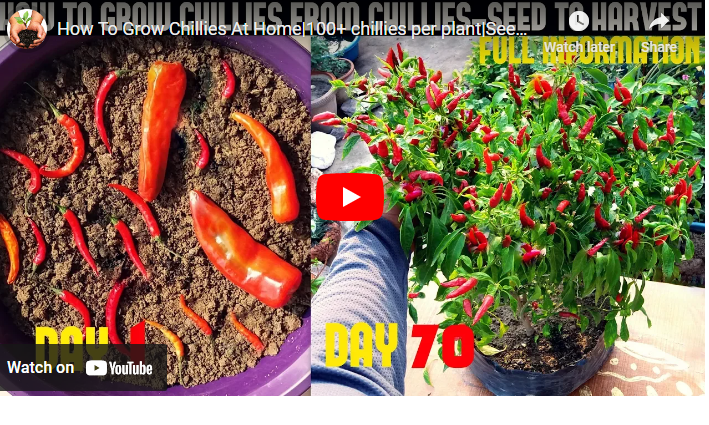Growing chili from seed can be a rewarding experience, especially in a vibrant city like Singapore. Whether you have a spacious garden or a small balcony, cultivating chili plants is an excellent way to add some spice to your homegrown produce.
To grow chili from seeds in Singapore, start by sowing the seeds in a well-drained pot or tray filled with quality potting soil. Keep the soil consistently moist, provide ample sunlight or artificial light, and transplant the seedlings to a larger container or garden bed once they have grown a few inches tall. With proper care and regular watering, you can expect to harvest fresh chili peppers within 2-3 months.
In this step-by-step guide, we will explore the process of growing chili from seed in Singapore and help you create a thriving chili garden.
How to Grow Chili from Seed in Singapore: Step-by-Step Guide
Choosing the Right Chili Seeds
To start your chili-growing journey, it’s crucial to select the right chili seeds suitable for Singapore’s climate. Opt for chili varieties that are known to thrive in warm and humid conditions. Popular choices include Thai chili, bird’s eye chili, and cayenne pepper. Consider purchasing seeds from reputable suppliers or nurseries to ensure quality and authenticity.
Preparing the Soil
Before sowing chili seeds, prepare the soil to provide a fertile environment for the plants to grow. Ensure your soil is well-draining and rich in organic matter. Singapore’s soil tends to be clayey, so adding compost or well-rotted manure will improve its structure and nutrient content. Additionally, incorporate perlite or vermiculite to enhance drainage and aeration.
Germinating Chili Seeds
To germinate chili seeds successfully, create a favorable environment with consistent warmth and moisture. Start by filling small pots or seed trays with seed-starting mix. Sow the chili seeds about 1/4 inch deep and cover them lightly with soil.
Place the pots or trays in a warm location, such as a sunny windowsill or a heated propagator. Maintain a consistent temperature of around 25-30°C (77-86°F) for optimal germination.
Transplanting Seedlings
Once the chili seedlings have grown a few sets of leaves, they are ready for transplanting into larger containers or the ground. Choose containers with good drainage holes or prepare a garden bed with well-prepared soil. Carefully remove the seedlings from the pots or trays, taking care not to damage the delicate roots. Place each seedling in its new location and gently firm the soil around it.
Caring for Chili Plants
Watering and Fertilizing
Chili plants require regular watering to keep the soil consistently moist, but not waterlogged. Avoid overwatering, as it can lead to root rot. Mulching around the base of the plants helps retain moisture and reduce weed growth.
Additionally, fertilize the chili plants every few weeks with a balanced organic fertilizer to provide essential nutrients for healthy growth.
Pruning and Supporting
To encourage bushier growth and maximize fruit production, prune your chili plants when they reach a height of 8-10 inches. Pinch off the top growth to stimulate lateral branching. As the plants grow, provide support such as stakes or cages to prevent them from bending or breaking under the weight of the peppers.
Managing Pests and Diseases
Chili plants are susceptible to pests and diseases, but with proper care, you can minimize their impact. Regularly inspect the plants for common pests like aphids, whiteflies, and caterpillars. Introduce natural predators like ladybugs or use organic pest control methods when necessary.
Monitor for signs of diseases such as powdery mildew or bacterial spot and take appropriate measures to control them.
Harvesting Chili Peppers
Once your chili plants start producing mature peppers, it’s time to harvest them. Chili peppers can be harvested at different stages of ripeness, depending on your preference for heat. Use clean gardening shears or scissors to cut the peppers from the plant, leaving a short stem attached. Handle the peppers with care, especially if you’re working with hot varieties, as they can cause skin irritation.
Can I grow chili from store-bought peppers?
While it’s possible to grow chili plants from store-bought peppers, it’s not always guaranteed. Many commercially sold peppers are treated with chemicals to prevent germination. It’s best to start with fresh, untreated chili seeds for a higher chance of success.
How long does it take for chili seeds to germinate?
Chili seeds usually germinate within 7 to 14 days, but the exact time can vary depending on various factors such as temperature, moisture, and seed quality.
How often should I fertilize my chili plants?
For optimal growth, fertilize your chili plants every 2-3 weeks using a balanced organic fertilizer. Follow the instructions on the fertilizer package for the correct dosage.
Can I grow chili in pots on a balcony?
Yes, chili plants can be grown in pots on a balcony as long as they receive sufficient sunlight and care. Choose compact chili varieties suitable for container gardening and ensure the pots have good drainage.
Are chili plants perennial or annual?
Chili plants are usually grown as annuals, but some varieties can be treated as perennials in tropical climates like Singapore. With proper care, they can continue producing peppers for multiple years.
Conclusion
Growing chili from seed in Singapore is a gratifying experience that allows you to savor the flavors of homegrown spice. By following this step-by-step guide, you can successfully cultivate chili plants from seed and enjoy a bountiful harvest. Remember to provide the right growing conditions, care for the plants diligently, and be patient as you witness the progression from seeds to fiery peppers.




